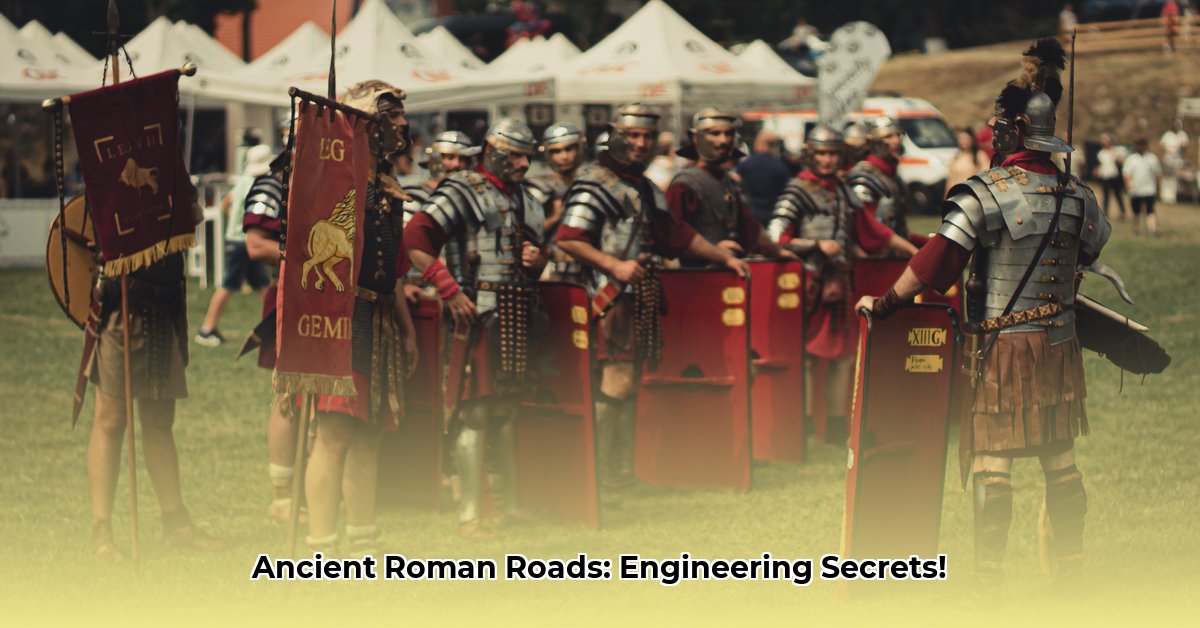Have you ever paused to consider the silent architects of the Roman Empire’s unparalleled dominion? Beyond the legions and the emperors, a vast, intricate network of roads served as the very sinews of Roman power, enabling unprecedented military control, fostering vibrant economic exchange, and profoundly shaping cultural diffusion across one of history’s greatest civilizations. These were not mere pathways, but advanced engineering marvels that connected the Mediterranean world, from distant Britain to the Euphrates, and from the Danube to North Africa. Their construction techniques, logistical precision, and strategic imperative set a benchmark for infrastructure that, in many ways, remains unmatched for its enduring legacy. This article delves into the remarkable story of Roman roads, unveiling the genius behind their design, exploring their multifaceted impact, and drawing valuable lessons that continue to resonate in our modern world. For more reading, explore these interesting facts about ancient Rome roads.
Roman Roads: Engineering Genius and Imperial Highways
Key Takeaways:
- Roman roads were a vital physical infrastructure, integral to the maintenance and development of the Roman state from 300 BCE onwards.
- The network encompassed over 400,000 kilometers (250,000 miles) of roads, with over 80,500 kilometers (50,000 miles) stone-paved.
- Engineers prioritized directness, using advanced surveying and construction techniques like layered foundations and sophisticated drainage.
- These roads facilitated rapid military deployment, efficient official communications, and robust trade, serving as a visible symbol of Roman authority.
The Arteries of an Empire
Imagine an empire spanning millions of square kilometers, its influence reaching across diverse topographies and cultures. How did Rome manage such a massive and fragmented domain? The answer lies significantly in its unparalleled network of Roman roads. As the historian Dionysius of Halicarnassus eloquently stated, “The extraordinary greatness of the Roman Empire manifests itself above all in three things: the aqueducts, the paved roads, and the construction of the drains.” These thoroughfares, known in Latin as ironically simple viae Romanae, were built from approximately 300 BCE, expanding and consolidating with the Roman Republic and later, the Roman Empire. They provided highly efficient means for the overland movement of armies and officials, enabling swift military responses and effective administrative control. Beyond their military utility, these roads were crucial for the inland carriage of official communications and, perhaps most importantly, for the vibrant flow of trade goods that fueled Rome’s economic might.
At the peak of Rome’s development, no fewer than 29 great military highways radiated from the capital, and the empire’s 113 provinces were interconnected by 372 major arteries. This vast system comprised more than 400,000 kilometers (250,000 miles) of roads, of which an impressive 80,500 kilometers (50,000 miles) were meticulously stone-paved. In Gaul alone, over 21,000 kilometers (13,000 miles) of roadways were improved, and in Britain, at least 4,000 kilometers (2,500 miles). The directness of these roads was legendary; many long sections are ruler-straight, cutting through hills or traversing ravines on bridgework, showcasing the Roman preference for engineering solutions over topographical circumvention.
Masterful Construction: Building for Millennia
What enabled these ancient infrastructures to endure for millennia, with some sections still in use today or serving as foundations for modern routes? The answer lies in the Romans’ profound understanding of road building techniques and their innovative use of materials. Roman engineers, often highly trained agrimensores (land surveyors) and libratores (levelers), employed sophisticated methods to ensure durability and minimal repair needs.
Their meticulous construction process, which varied slightly by region and available materials, typically involved several layers:
- Fossa (Excavation): The process began by digging a trench (or fossa) down to bedrock or the firmest ground available. The depth varied according to terrain and soil stability.
- Statumen (Foundation): Large, flat stones were carefully laid into the fossa, often set in cement or rammed earth, forming a robust foundation. In marshy areas, rafted or piled foundations were used.
- Rudus (Coarse Concrete): A layer of coarse concrete, typically a mix of aggregate and hydraulic mortar (often containing pozzolana, a volcanic ash that revolutionized Roman concrete), was then applied, providing excellent stability and drainage.
- Nucleus (Fine Concrete): This layer consisted of fine concrete, creating a smoother, denser core that further strengthened the roadbed and prepared it for the final surface.
- Summa Crusta (Pavement): The crowning layer featured precisely cut polygonal or rectangular paving stones, often local rock like basalt (silice) or limestone, meticulously fitted together. These were cambered (crowned in the center) to ensure efficient rainwater runoff into flanking drainage ditches or footpaths.
This layered approach, combined with engineered solutions like bridges and tunnels, made Roman roads remarkably resilient to rain, freezing, and flooding. Their emphasis on constructing straight roads minimized travel distance, saving both time and materials. While some early roads simply followed leveled earthen tracks (viae terrenae) or had gravel surfaces (viae glareatae), the multi-layered paved viae munitae became the standard for major public highways, a testament to unparalleled engineering achievement.
The Multifaceted Impact: Trade, Culture, and Administration
Key Takeaways:
- Roman roads significantly boosted economic growth by facilitating the unhindered movement of goods and people across the vast empire.
- They promoted widespread cultural exchange, unifying diverse regions and contributing to a shared Roman identity.
- A sophisticated administrative and logistical system, including milestones, way stations (mansiones, mutationes, tabernae), and a public postal service, supported the road network.
- The roads were subject to defined legal rights and responsibilities, with construction and maintenance overseen by various officials and, at times, private citizens.
Highways of Prosperity and Connection
The influence of Roman roads extended far beyond military logistics. They were the very arteries of commerce, profoundly fueling economic development across the vast Roman territories. By connecting remote regions and major urban centers, they drastically reduced travel times and transportation costs, making it easier to transport goods, resources, and even livestock. This unparalleled connectivity directly led to increased trade, stimulating local economies and integrating them into the broader imperial market. Imagine merchants traveling with greater security and speed, their goods reaching new markets, or essential supplies quickly moving to support burgeoning cities or legions.
Beyond economic benefits, these ancient trade routes were powerful catalysts for cultural exchange. The constant flow of people—soldiers, merchants, administrators, and ordinary citizens—along these roads facilitated the rapid spread of Roman law, Latin language, religious practices, architectural styles, and philosophical ideas. This cultural integration played a crucial role in unifying the diverse provinces of the empire, fostering a sense of shared identity and allegiance to Rome. The roads were not simply pathways; they were conduits of Romanization itself.
Administration and Logistic Backbone
Maintaining such an extensive and vital network required a sophisticated administrative and logistical system. Roman law defined the right to use a road as a servitus, with public roads (viae publicae) being state-owned and maintained at public expense, often under the supervision of curatores (commissioners) and redemptores (contractors). Private roads (viae privatae) and local village roads (viae vicinales) also existed, with varying maintenance responsibilities falling to landowners or local magistrates.
Key elements of this supporting infrastructure included:
- Milestones (Miliarium): These circular columns, typically standing 1.5 meters (5 feet) tall, were placed every milia passuum (thousand paces, approximately 1,476 meters or 4,843 feet). They indicated the distance to the Roman Forum and identified the officials responsible for their construction or repair, serving as invaluable historical documents. Augustus even established the miliarium aureum (“golden milestone”) in Rome, from which all major roads were considered to begin, symbolizing the centrality of the capital.
- Way Stations:
- Mansiones (“Staying Places”): Located approximately 25-30 kilometers (16-19 miles) apart, these were state-maintained villas offering lodging and services primarily for officials and those on imperial business.
- Cauponae (“Inns”): Private establishments near mansiones, offering similar services but often viewed as less reputable.
- Tabernae (“Hostels”): Evolved from mandatory hospitality, these were more luxurious private establishments, some growing into significant complexes around which modern towns developed.
- Mutationes (“Changing Stations”): Positioned every 20-30 kilometers (12-19 miles), these complexes provided services for vehicles and animals, including wheelwrights, cartwrights, and veterinarians. They were crucial for the efficiency of the cursus publicus, the state postal service, which could carry letters up to 80 kilometers (50 miles) a day by horse relay.
Security on the roads was also paramount. Imperial troops, notably stationarii and beneficiarii, patrolled the routes from police posts and watchtowers, deterring criminals and ensuring the safety of travelers and goods. This combination of robust engineering, strategic placement, and comprehensive logistical support ensured the continuous functionality of the Roman road network for centuries.
Enduring Legacy and Modern Relevance: Roman Roads in Our World
Key Takeaways:
- Many modern routes in Europe and the Middle East still follow or overlay original Roman road courses, a testament to their lasting influence on modern road design.
- Research indicates a correlation between the density of ancient Roman road networks and higher modern road density and economic activity, highlighting the long-term impact of early infrastructure investment.
- The persistence of Roman road influence depends on the continuity of wheeled transport, demonstrating the need for infrastructure adaptation as transport needs evolve.
- Lessons from Roman engineering, particularly in durability, drainage, and concrete innovation, continue to inspire contemporary sustainable construction and urban planning.
Pathways to the Present
Have you ever considered how ancient pathways might still be shaping our world today? The enduring legacy of Roman roads is undeniable. Many modern routes, particularly across Europe and parts of the Middle East, directly follow or are built upon original Roman alignments. This is not merely historical curiosity; it’s a testament to the foresight and engineering prowess of the Romans. Studies have shown that regions with a higher density of Roman road networks often correlate with greater modern road density and increased economic activity, underscoring the profound, long-term impact of early infrastructure investment on economic geography. The proverb “All roads lead to Rome” encapsulates not only the centrality of the capital but also the lasting influence of its integrated transportation system.
The strategic placement of these ancient thoroughfares, initially driven by military conquest and administrative control, inadvertently laid the groundwork for future trade routes and the development of market towns that thrived along these corridors during the medieval period. This historical precedent offers invaluable insights into the formation and persistence of economic hubs.
Lessons from Ancient Ingenuity
The Roman approach to civil engineering continues to offer profound lessons for today’s designers and planners. Their emphasis on durability, efficient drainage, and the innovative use of materials like pozzolana-based concrete—which possessed remarkable strength and even self-repairing qualities—provides a compelling model for sustainable construction. Modern research into concrete technology, for instance, often looks to Roman examples for inspiration in creating more resilient and long-lasting materials.
However, the enduring influence of Roman roads is not universal. In regions like North Africa and the Middle East, the correlation between ancient Roman roads and modern development weakens significantly. This is largely attributed to the abandonment of wheeled transport in favor of caravan trade routes, which did not necessarily align with the Roman network. This serves as a critical reminder that infrastructure adaptation is vital for long-term relevance, as transport needs and technologies evolve over time.
A Comparative Glance: Roman vs. Modern Roads
While modern roads prioritize speed, mass transit, and complex safety features, a comparative analysis of Roman roads vs modern roads reveals intriguing parallels and contrasts:
| Feature | Roman Roads | Modern Roads |
|---|---|---|
| Primary Purpose | Military movement, administrative control, imperial expansion, fostering economic and cultural exchange. | Mass transit, economic efficiency, facilitating commerce, tourism, and daily commuting. |
| Construction | Multi-layered system (fossa, statumen, rudus, nucleus, summa crusta) using local stones, gravel, and hydraulic concrete (often with pozzolana). Roads cambered for drainage. Precise surveying with tools like groma. | Multi-layered systems (subgrade, subbase, base course, surface course) using asphalt, Portland cement concrete. Advanced drainage systems (gutters, storm sewers). Computer-aided design, precise grading, and material testing. |
| Alignment | Direct, often ruler-straight, regardless of minor geographical obstacles (e.g., cutting through hills, building bridges). | Engineered for safety (e.g., gentle curves, controlled gradients), optimized for higher speeds and traffic volumes, often following contours to minimize environmental impact and construction costs. |
| Longevity | Designed for extreme durability, with many sections surviving for centuries and some still in use. | Designed with varying lifespans (e.g., 20-50 years for major highways), requiring regular maintenance and periodic reconstruction due to heavy traffic, climate, and material degradation. |
| Supporting Infrastructure | Milestones, mansiones, mutationes, tabernae (way stations for officials, travelers, and vehicle servicing), cursus publicus (postal service), roadside security. | Road signs, rest areas, service stations, weigh stations, emergency services, intelligent transportation systems (ITS) for traffic management and information. |
| Environmental Impact Awareness | Limited systematic awareness, but local resource use and durable construction indirectly led to long-term sustainability. | Extensive environmental impact assessments, focus on minimizing ecological disruption, managing runoff, reducing noise pollution, and exploring permeable materials and green infrastructure. |
By studying the Roman model, modern engineers and planners can gain invaluable perspectives on creating more resilient, strategically sound, and sustainable infrastructure. The Roman legacy reminds us that infrastructure is not just about getting from point A to point B; it is a fundamental element that shapes societies, economies, and civilizations in profound and enduring ways.










